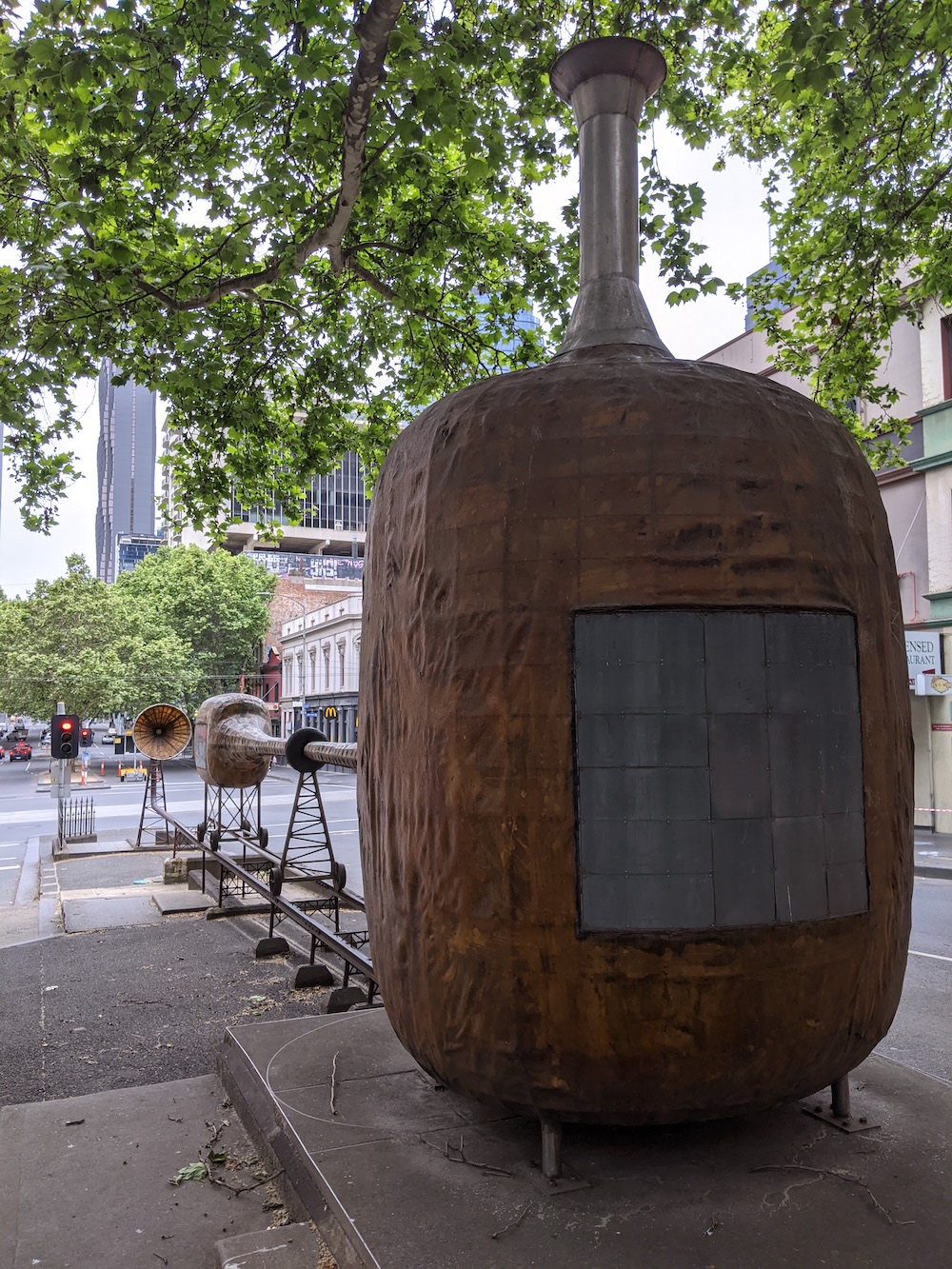LOCATION: Corner Bourke and Russell Sts (former underground toilets)
It might seem unglamorous now, but, in 1902, when the underground toilets formerly in operation at this site were built, women had just gained the right to vote and sit in Federal Parliament.
These toilets were the first public women’s toilets built in Melbourne, with four water closets, two wash basins, a store room and an attendant’s room, they cost a penny to use and were an important, if often underrated, signifier of sanitary, technological and social reform. Beside the site sits Chris Reynold’s sculpture, “A History apparatus – Vessel Craft & Beacon”, a somewhat confusing and inauspicious sculpture with limited relevance to the site’s former use.
Quinn Eades visits this location in his mind’s eye; deep in coronavirus lockdown, this once monumental toilet could be as far away as the moon, as bamboozling as the nearby statue or as portentous as any of our many possible futures. No one can clearly remember what the city used to be like at this strange time. But Quinn’s call to action is as political as the toilets once were: renaming a city, its spaces and histories; making space for women, trans and nonbinary people; respecting and returning to the land and environment; bringing art into unexpected places; and welcoming all bodies in all guises.
TRANSCRIPT:
I am asked to imagine a feminist future for a place in Naarm (now called Melbourne) on Wurundjeri land. I am given a list, a grid with numbered dots to choose from, and I read this list, think about old and now and future cities, and I pick this place, at the corner of Bourke and Russell Streets, where the first women’s toilet was installed in 1902. It is October 2020 and I haven’t seen the inside of a public toilet for months. I live in Reservoir, 13km from this place, and it is a State of Emergency here, so this corner in the city of Melbourne, which is well over 5 kilometres away from my home, could be a corner across the warming sea, could be bleached under a midnight sun, could be buried under red dirt snow – right now there is no getting anywhere so to get there I fly fibre cabled into satellite into street view and there it is.
There isn’t a toilet on this corner anymore. It is marked, instead, by a 24 metre long sculpture named A History Apparatus – Vessel, Craft and Beacon, by artist Chris Reynolds, in 1995. The City of Melbourne’s website tells me that “the main components of this sprawling sculpture… refer to the temporal concepts that anchor us in the world: the vessel represents the past, the craft represents the present and the beacon the future.” If the present is this craft, an unwieldy and fragile airship, hydrogen filled and billowing in a viral wind, then how to get to a future that is a beacon, a light thrown ecstatic through a darkening sky, how to move to any future at all. The word beacon has old english roots, and means sign or signal, lighthouse, means portent. Maybe portent is the work I’m looking for when I walk through empty Melbourne streets and the silence has its own suffocating weight and we meet no other person’s eye, and all bodies are frightened and frightening. Omens everywhere. Hard to push through, to think anything but what this craft we find ourselves in is made of, to think can there be more than fire and flammable silk between all of us and a sickening fall made from embers and science gone wrong.
So a feminist future for this place? This city I am writing about will be called by its Wurundjeri name, Naarm. The streets where we find this corner will no longer be named after Sir Richard Bourke, Governor of NSW, who issued a proclamation implementing terra nullius in 1835, or after Lord John Russell, who served as UK Prime Minister in the mid 1800s, was never fully in support of suffrage, and is far removed from this city, this corner, its sculpture, its first women’s toilet, its many stories and layers that stay, even when concrete is laid. Streets will take new names that are old names. This corner will keep its sculpture, will feed stories from First Nations peoples directly to your neural implant, will contain a fully accessible women’s, trans, and nonbinary toilet in its underground, which will no doubt be self composting, incredibly safe and clean, with endless supplies of free bio degradable tampons, pads, condoms, and nappies. There will be art and poetry on the walls. It will be soft and not scary and no one will tell anyone else they don’t belong there, that their bodies should be kept closed, should not leak, should not bleed. A feminist future is this possibility, past burning and falling, the one that Le Guin and Butler and Starhawk saw, this beacon, this time.
This work is a part of the Queen Victoria Women’s Centre collaboration, Taking Space, for Feminist Journeys, featured as a part of the 2020 Feminist Writers Festival.



Thank you for your post. I now see the street naming differently, something to reflect on my next visit to Melbourne.